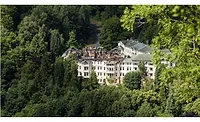The Anatomy of a Fire: Understanding 3 Types of Fires & Effective Cleaning Techniques
According to the National Fire Protection Association, it’s estimated that some 370,000 home fires occur each year, costing close to $7 billion in total property damage. In many of these home fires, however, the fire starts and is contained in a certain area of a home or business. Even though containment eliminates the necessity for complete demolition and reconstruction, it is still necessary for proper cleaning of soot and smoke to commence, in order to restore the property to a pre-loss condition.
Anatomy of a Fire
Contrary to what many may believe, there is more than one type of fire — and the type of fire that occurred will dictate the appropriate cleaning method. The most prevalent types of fires are: high-oxygen fires, which produce dry soot; low-oxygen fires, which produce greasy, wet soot, and kitchen fires. Here’s a closer look at how to clean each type of fire:
- High oxygen: Dry sponges are a must. Follow this by applying a low-alkali detergent and then rinse thoroughly.
- Low oxygen: Use high-alkali detergents along with warm water to wash the walls and structures. Rinse, then paint over.
- Kitchen: These are often the most challenging fires to clean, as soot residue is difficult to detect. For this reason, cabinets, drawers and other appliances often need to be removed to adequately clean the area.
General Cleaning Techniques
Smoke and soot can penetrate paint, carpet, upholstery and clothes. While carpet can be deep cleaned and clothes can be taken to the dry cleaner, properly restoring walls, structures and objects is a different story. Here’s a look at some general cleaning techniques:
- Personal protective equipment: Gloves, a protective mask, long-sleeved shirts and pants should be worn on site to minimize contact with ash.
- Remove contents: Remove contents from the house. While some contents may have to be discarded, others can be effectively hand cleaned. Cleaning contents in an ultrasonic machine is also an option with some items.
- Ventilate: Open windows and doors to remove odor.
- Beware of other contaminants: Lead and asbestos can turn a fire restoration job into an environmental restoration job if they’ve become disturbed.
- Hand scrubbing: Fire damage work is one of the most tedious types of repair work. It involves a lot of handwork, such as scrubbing walls and structures with sponges — and using chemicals and specialized restoration equipment, such as media blasting tools, in the event of heavy residue.
- Duct cleaning: Following restoration, a duct cleaning is required. That’s because smoke and soot have a tendency to become trapped within a home or business’s duct system. This can spread contaminants — and odors — to other areas of the home when in operation. Hence, a professional duct cleaning is necessary.
Techniques for Various Materials
- Clothes and fabrics: A specialized dry cleaner is capable of restoring these items to pre-loss condition. Cleaning soot-contaminated clothing is somewhat of a science, and while a homeowner may be able to adequately restore clothing on his own, it’s always best to leave this to the professionals.
- Carpet: A professional carpet cleaning is a must in order to effectively remove contaminants and odor from the carpet.
- Building materials: Dry chemical sponges are your best bet for wallboard, plaster, wood and wallpaper. These will remove much of the soot and also prevent it from being lodged deeper into the material.
- Other materials: Sponges, towels and mops are ideal for cleaning tile, glass, metal and certain appliances. Since these aforementioned objects are less porous than drywall, for example, it’s OK to use a wet or dampened sponge or cleaning tool. Plus, there’s no risk of lodging contaminants deeper into the material.
- Specialty cleaning tools: Ultrasonic cleaning machines can come in handy as they can adequately clean non-porous items quickly and efficiently, compared to hand cleaning.
When it comes to a fire damage situation, you also need to remember how vulnerable the homeowner is in the situation. While any type of home catastrophe is never welcome, a fire has the potential to be the most devastating. With that in mind, also be sure to work on your customer service skills, communicate effectively and regularly with the homeowner to determine his needs throughout the process, and keep him up to speed on the project’s progress.
Where a water damage situation can be restored in as little as three days, it’s not uncommon for a fire damage situation to last several weeks — or even months if reconstruction is involved. Hence, proper cleaning and handling of a project is all the more important.
Looking for a reprint of this article?
From high-res PDFs to custom plaques, order your copy today!







